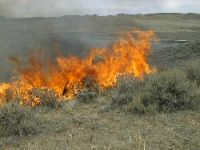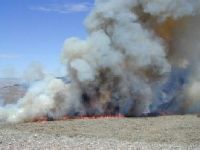Fuels & Fire Management
It's a powerful force. When it's out of control and out of proportion, the results are disastrous. But when fire is used in a safe manner at a certain time of the year under specific environmental conditions the benefits can be outstanding.Prescribed burning allows fire to play its natural role in the environment under controlled conditions. BLM uses prescribed fire to: a) enhance and improve habitat for wildlife; b) reduce hazardous fuels; c) prepare sites for seeding or planting; d) manage competing vegetation; e) control insects and disease; f) sustain fire-dependent species; and, g) improve and enhance forage quality and quantity for livestock.
Fire is a natural process in many plant communities. Years of shrubbery growth and leaf litter are cleared away and ideal conditions for the regeneration of many plant species are created. Many plants depend on fire to heat and scar their seeds as a process for germination. For example, lodgepole pine trees have cones that open when mature. But on some pines most of the cones remain closed. They open and release seeds only when they're heated--even seeds that have been in cones for 50 years.
Wildlife also adapt to the changes brought about by fire. The open habitat is easier to move about in, provides more sunlight, and in turn supports a greater diversity of forage plants. Prescribed fire benefits deer, turkey, quail and other birds by regenerating nutritious browse, increasing the number of food insects, clearing the ground between grass clumps, and favoring legumes.
Prescribed burns prevent forest fires by clearing out vegetation, such as small trees, shrubs, and brush, which can eventually fuel a much larger fire. Fire fighters can allow lightning fires to burn with less danger if fuel materials within the immediate vicinity of buildings, campgrounds, and homes are cleared away. Curtailing fuels also reduces the intensity of wildfires, which leads to easier management of them because they become more predictable and less powerful.
Links









